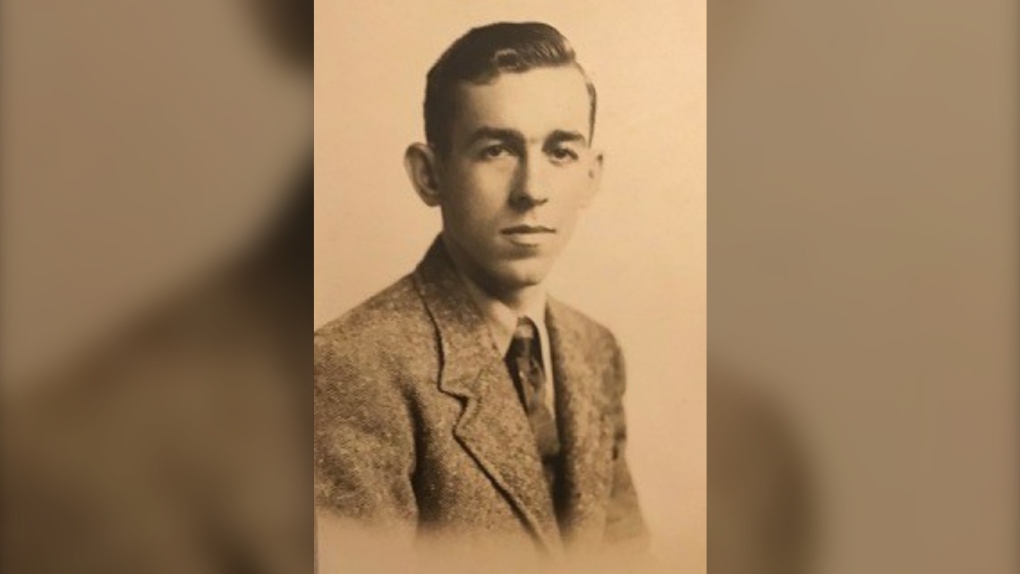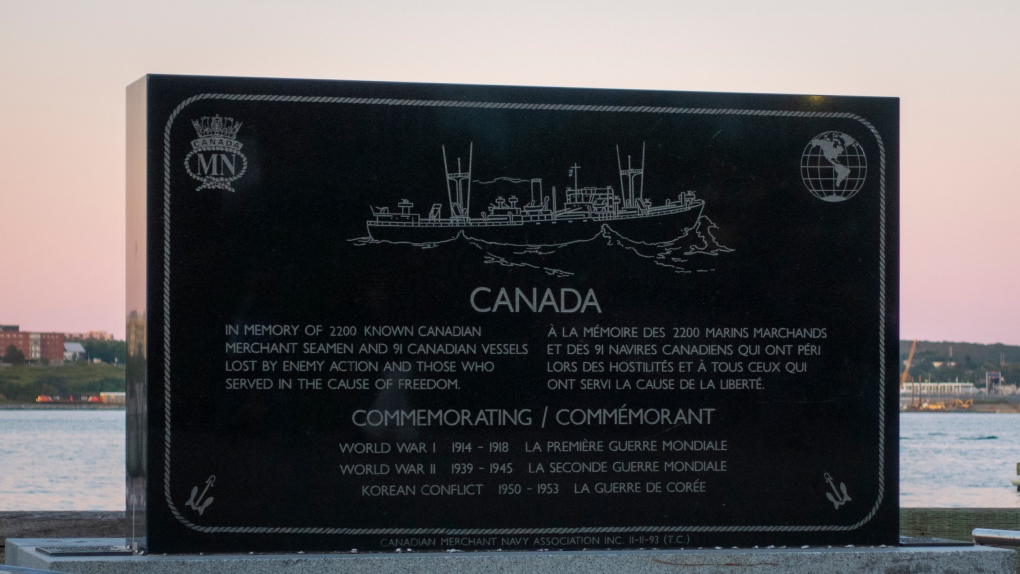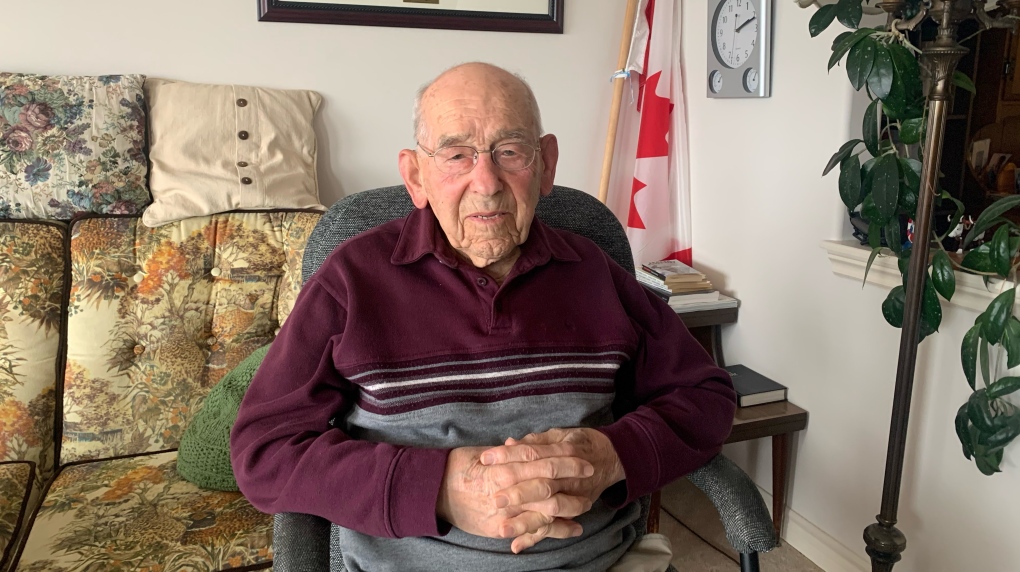Late N.S. veteran featured in new video honouring Canadian Merchant Navy
Testimony from a late Nova Scotia Second World War veteran has been released Tuesday, on what is Merchant Navy Veteran’s Day.
Captain Earle Wagner is featured in a new video by The Memory Project called "The Forgotten Navy."
The Memory Project is a Historica Canada program that arranges for veterans and Canadian Forces members to share their stories at schools and events across the country. The organization also has thousands of recorded interviews with veterans, which are available online.
Their latest video highlights the Merchant Navy’s contribution during the Second World War and their fight for rightful recognition.
Wagner gave his final interview to The Memory Project a few months before his death on Dec. 1, 2023. He was just a few weeks shy of his 100th birthday.
Joining the Merchant Navy
Wagner was born in West LaHave, N.S., on Christmas Day 1923, and worked at a local woodworking factory after finishing school. He then decided to join the Navy Royal Canadian Navy but was rejected.
"Several months later, at the time I was 17 then in 1941, I joined the Canadian Merchant Navy, and I made it a lifetime career," he said during the interview.
 A photo of a young Earle Wagner. (Source: Historica Canada)
A photo of a young Earle Wagner. (Source: Historica Canada)
"Unlike the Royal Canadian Navy, the Canadian Merchant Navy consisted of former civilian ships and government-run vessels crewed by Merchant sailors who were not members of the armed forces," The Memory Project video explains.
In his interview, Wagner spoke about how people were struggling with poverty and unemployment at the time he joined the Merchant Navy.
"We're all looking for a job, or something to do, and most always wanting to help our country. I don't know whether or not we're patriotic or not, but all of those people are trying and so many of them [joined] the operation, as in the Army, Navy and Air Force... I had to follow my dreams."
Wagner recalled a time, years after joining the Merchant Navy, when his former teacher told him she remembered him "quite well" for writing an essay about wanting to be captain of an oil tank when he was in Grade 6.
"She said 'you did all those things'... She knew all about me, she didn't forget me." he said. "In 1941, that's when I was going to sea, learning all the things generally about seamanship. My intentions were someday to become a ship's officer, or a captain. (That's) what I said in my essay, which I had forgotten all about."
Wagner wasn't the only member of his family to join the Merchant Navy, he had an uncle who was also a captain
"I almost kind of looked up to him. I was named after him... You have a very good job and made about $150 a month, the majority of people [were] working for a dollar a day, so he set an example that I thought I should go on, and I did," he said.
On-the-job training
According to Wagner, there were no training programs when he joined the Merchant Navy.
"It was all on-the-job training, so naturally you followed that. They put you together with actual seaman, or somebody with more experience than you had, and you learned by watching and doing things, by making mistakes and learning just like you do when you go to school," he said.
Wagner added he was "very fortunate" to have sailed the same ship for a total of 26 months.
"In 1943, when I was 19-years-old, I went to the navigation school, government navigation school, in Yarmouth, N.S., and there was a very good friend of mine, the two of us went together, we joined the ship together, and we spent about five weeks in school and we knew enough to pass the navigation part of it, then seamanship and the signals and all the other stuff like that, first-aid and so on. That generally gave you an introduction into becoming what you call a watchkeeping mate, that's what you are right after you pass that examination."
Wagner mostly served on oil tankers in the Merchant Navy's north-south run.
"The first part of the war, we weren't in convoys, and later on we were. But we've been around to Colombia and Venezuela and carrying the cargo of crude oil back to Halifax, Montreal, Portland, Maine, New York... we weren't just carrying any other cargos. These ships were designed to pull all kinds of pipelines and pumps and so on, and oil, but not all the cards."
'The black pit'
Merchant Navy veterans shared memories of their experiences of facing the “black pit” – an undefended and dangerous part of the Atlantic Ocean where many ships were lost to German U-boats – in The Memory Project’s new video.
Wagner described a "dangerous time" in the spring of 1942 when he saw several ships sinking off the east coast of the United States.
"The ship I was on was going almost 10, 11 knots an hour during the daylight hours... I made a point to sort of keep a look out early in the morning and daylight and I counted 14 ships that sunk," he said.
"The Americans were ill prepared for them, for a range of more than 1,500 miles, they only had two anti-submarine vessels to counteract them, so they were like sitting ducks. The Americans didn't even turn off the lights so all they had to do, the German submarines, is turn on sub images, wait outside of the route that the ships took north and south up the American coast, and they just picked them off. They could see them in the darkness, even though they were blacked out, they could see the silhouette of it against the light."
Wagner said the strongest memory of his time serving was seeing so many ships lost.
"That still stays with me. I can still visualize those ships," he said. "That was probably the most catastrophic event that stayed with me. Or how many times we went through a stream, in one hour about 10 knots, about 10 miles, with oil. We know the ship; we know the tanker ahead of us was coming through the Caribbean Windward Passage. And we knew there was a ship, and a torpedo. We didn't know of the submarines... everybody was nervous. We were alone, too, we had no convoy."
"Other than that, being so young, we were teenagers and, some of the times you were a little bit scared," he added. "To know you could get torpedoed, everyone would have to get in the lifeboats."
Fighting for recognition
Of the more than 12,000 men and women who served in the Canadian Merchant Navy during the Second World War, 1,629 died, according to the Canadian Armed Forces.
The causality rate was one in seven, a higher percentage of total casualties than other branches of Canada's military.
Despite the dangers they faced, those who served in the Merchant Navy were not recognized by the Canadian government as veterans after the war and Wagner was involved in the fight to get that recognition.
He said he first started writing to the government in 1966.
"Here was the naval personnel, and I was a Merchant Navy. (They were) entitled to a lot of things that I wasn't to, in other words -- they called us civilians. That's what we were to them, even though we're right to be equal to what the other service personnel are doing," he said.
Wagner was among those who pushed Ottawa to provide Merchant Navy veterans the same recognition and benefits as their counterparts in the Canadian Armed Forces. They won their fight in 1992, although it wasn’t until 2000 that retroactive benefits were paid out back to the end of the Second World War.
"We got the government to put up the money, and pay these people that served. It was 12,000 veterans, Canadian veterans," he said, adding it was good news for the veterans who were still living and for any late veterans’ widows.
Wagner was also involved in getting a Merchant Navy memorial installed on the Halifax waterfront, featuring the names of 91 lost ships.
 A memorial for the Canadian Merchant Navy is pictured on the Halifax waterfront.
A memorial for the Canadian Merchant Navy is pictured on the Halifax waterfront.
"That represents, you've got to remember, almost 2,200 Canadians lost in World War I or World War II and the 91 ships in both wars lost to enemy action," he said.
It took him a year-and-a-half to bring the memorial to fruition, something he called a "major accomplishment."
"I had to do a lot of things, personally, to raise the money, so I had to write letters, and I raised $20,000,” he said. “A memorial was in stone, the biggest stone I could get was about six-feet long, about three-and-a -half feet high, 10 inches thick and so on, like 5,500 pounds heavy, and engraved."
Speaking to students
After the war, Wagner had a long career in the marine industry and also shared his stories of service with young students.
He said he was motivated to share his experiences because he believed in the job he did.
"It was a worthwhile job... I put my life on the line for my country in war time, as a 17-year-old boy and just as well as somebody who joined the Army, Navy, or Air Force. And we should've gotten the full recognition as being equal to (them).”
Wagner said he liked to talk to students about commonality, something he experienced during the war.
"We all had a common interest, and that was to defeat the enemy, defeat Hitler and we thought about all the different ways," he said.
"The common interests of different nationalities got together because of mixtures of ships crews through several different nationalities and so on. You work together too, as a team, to find that closeness."
The key to longevity
Wagner was five months shy of his 100th birthday at the time his last interview with The Memory Project was recorded. He said he was often asked, "What's the key to your longevity?"
"I said twofold; an active mind and an active body ... secondly, it's lifestyle,” he said. “You know you're not a boozer, smoker and all this kind of stuff, and living a riotous life. Number three, four letter word. starts with L, and it ain't love, what is it? L. U. C. K. So I never forgot that, I pull that one up on quite a lot of people," he said. "I guess I've done the right things."
 Merchant Navy Captain Earle Wagner is seen in this May 5, 2023, photo. (CTV Atlantic)
Merchant Navy Captain Earle Wagner is seen in this May 5, 2023, photo. (CTV Atlantic)
'A remarkable story'
Historica Canada president Anthony Wilson-Smith hopes viewers of The Memory Project video will learn about a story that "deserves much more attention."
"It comes down to this idea that a lot of people think Canadian history is boring, it's only boring to people who haven’t taken the trouble to find about it, and this is a perfect example of that," he said during a phone interview with CTV Atlantic.
"When you read what these people, men and women, went through on a daily basis, just constant fear, 24 hours, just a second and everything could blow up on you, and they did it for years. It's almost unimaginable now, but they just did."
Wilson-Smith says The Memory Project knew immediately that Wagner had to be in their Merchant Navy video when they first stated planning for it.
"He was a good speaker with a remarkable story to tell, and the Merchant Navy story is both one of the most heroic chapters in Canadian military history and also in some ways of course one of the most shameful, meaning how they were treated after the war, the lack of respect and recognition they got," he said.
"We knew, here's somebody born in West LeHave, a great story about an ordinary guy who lived an extraordinary experience with extraordinary courage, you had to have it to take part in all those missions."
For more Nova Scotia news visit our dedicated provincial page.
CTVNews.ca Top Stories

WATCH LIVE Gunman at large after UnitedHealthcare CEO fatally shot in apparent targeted attack, law enforcement official says
The CEO of UnitedHealthcare was shot and killed in midtown Manhattan Wednesday morning in an apparent targeted attack as he was about to attend the company's annual investor conference, a law enforcement official tells CNN. The gunman remains on the loose.
2 Quebec men top BOLO program's latest Top 25 list of Canada's most wanted
Two men believed to be central figures in Quebec’s violent and ongoing drug conflict topped the Bolo Program's latest Top 25 list of Canada's Most Wanted fugitives.
$80-million jackpot: 2 winning tickets sold in Canada
There are two winners of the $80 million Lotto Max jackpot, Ontario Lottery and Gaming (OLG) has announced. The prize will be split between two tickets sold in Quebec and Alberta, respectively.
Facial recognition to board a plane: How does it work, and what are the privacy concerns?
Air Canada has launched facial recognition technology at the gate for people flying out of Vancouver International Airport - with the promise of a faster boarding process with fewer hassles.
VPD issue public warning after random sucker punch at bus stop
Vancouver police have released security video as they seek witnesses to an unprovoked assault in the downtown core.
Trump considers DeSantis for the Pentagon with Hegseth under pressure over allegations: AP sources
The nomination of Pete Hegseth, U.S. president-elect Donald Trump's choice to lead the Pentagon, is under pressure as senators who would need to confirm him weigh a series of allegations that have surfaced against him.
These are Canada's favourite musicians, according to Spotify Wrapped 2024
One particular artist dominated the charts in Canada, and country music exploded in popularity this year, according to Spotify.
Mexico president says Canada has a 'very serious' fentanyl problem
Foreign Affairs Minister Mélanie Joly is not escalating a war of words with Mexico, after the Mexican president criticized Canada's culture and its framing of border issues.
Mexican troops seize a record fentanyl haul days after Trump threatened tariffs
Mexican soldiers and marines have seized over a ton of fentanyl pills in two raids in the north, with officials calling it the biggest catch of the synthetic opioid in the country’s history.

































